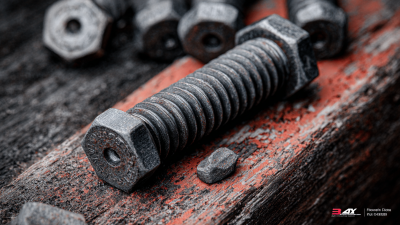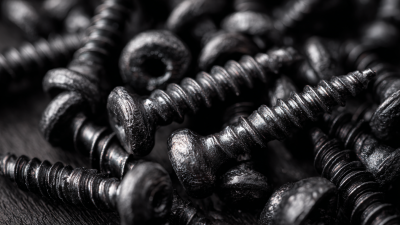Choosing the right Concrete Wall Anchors is crucial for ensuring the structural integrity and safety of various construction projects. According to the American Concrete Institute, improper anchoring can lead to significant failures, resulting in costly repairs and potential safety hazards. This necessity becomes even more pronounced as the construction industry continues to grow, with the U.S. cement consumption expected to reach over 106 million metric tons by 2024, illustrating the increasing demand for reliable anchoring solutions in concrete applications.
In this comprehensive guide, we aim to demystify the selection process by examining the top 10 Concrete Wall Anchors available in the market today. With several anchor types to choose from—ranging from expansion anchors to chemical anchors—making an informed choice is essential. Recent industry reports indicate that the effective use of the right anchoring products can enhance building durability by up to 30%, a vital consideration in both residential and commercial projects. Understanding the various factors that influence the selection of Concrete Wall Anchors, including load capacity and environmental conditions, will empower builders and DIY enthusiasts alike to achieve optimal results and maintain the longevity of their structures.

When it comes to securing objects to concrete walls, understanding the different types of concrete wall anchors is essential. The primary types include expansion anchors, wedge anchors, and adhesive anchors, each serving distinct purposes and offering varying levels of strength and installation complexity. Expansion anchors work by expanding against the sides of the drilled hole in the concrete as a screw is tightened, creating a firm grip ideal for lightweight applications. Conversely, wedge anchors provide a more robust solution, utilizing a tapered end that grips the sides of the hole tightly, making them suitable for heavy-duty fixtures.
For situations requiring even greater holding power, adhesive anchors are an excellent option. They involve the use of a resin that bonds the threaded rod to the concrete, delivering superior strength and stability. This type is particularly beneficial in applications prone to vibrations or dynamic loads. Understanding these differences can guide you in selecting the right anchor for your project, ensuring safety and longevity in your installations.
When embarking on a concrete wall project, one of the most critical aspects to consider is the evaluation of load requirements. Understanding the weight and type of objects you plan to attach to the wall will determine the appropriate anchor type and installation method. Each project has its unique demands; therefore, calculating the total load—including the weight of fixtures and any dynamic forces—ensures that you select anchors capable of providing sufficient support without risk of failure.
Moreover, load requirements vary not only by weight but also by the nature of the materials being used. For example, lightweight shelves may necessitate different anchors compared to heavy-duty machinery. Additionally, environmental factors such as whether the anchors will be exposed to moisture or extreme temperatures can influence your choice. By assessing these variables thoroughly, you can confidently choose the right concrete wall anchors that will enhance the durability and safety of your project, ultimately leading to successful and long-lasting installations.
Installing concrete wall anchors can seem daunting, but with a clear, step-by-step approach, you can achieve a sturdy and reliable installation. Before you begin, it’s critical to gather all your materials, including the appropriate anchors, a hammer drill, masonry bit, and a level. Start by determining the precise position for your anchor; accurate measurement is vital to ensure your fixtures hold properly.
Next, use the hammer drill and masonry bit to create holes in the concrete wall. Make sure to choose the right diameter for your anchor to ensure a snug fit. After drilling, it’s important to clean out the dust from the hole to enhance the anchor’s grip. Insert the anchor into the hole until it's flush with the wall surface, then secure it according to the manufacturer's instructions. Following these steps will not only enhance the functionality of your installations but also ensure safety and durability in your projects.
When selecting concrete wall anchors, many individuals fall into common pitfalls that can undermine their project’s integrity. One of the most frequent mistakes is misjudging the weight capacity of the anchors. It's crucial to precisely match the anchor type with the expected load; otherwise, you risk underestimating the strength required, which can lead to disastrous results, including damaged walls or fallen fixtures.
Another common error is neglecting the wall material when choosing anchors. Different materials such as drywall, concrete, or brick require specific anchor types to ensure a secure hold. For instance, using standard anchors in concrete without considering their specific properties can lead to inadequate installation. Taking the time to understand the unique characteristics of your wall can prevent future issues and ensure a stable and lasting setup. By steering clear of these mistakes, you can enhance the reliability and performance of your concrete fixtures.
Maintaining and inspecting your concrete wall anchors is crucial for ensuring their long-term performance and reliability. Regular inspections should be scheduled to check for signs of wear, corrosion, or any structural damage. Look closely at the anchor points for cracks in the surrounding concrete, as these could indicate weakening support. Additionally, it is important to examine the anchors themselves for any rust or degradation, particularly in outdoor settings where exposure to weather can accelerate deterioration.
In addition to inspections, proper maintenance plays a key role in extending the life of your concrete anchors. Clean the area around the anchors to remove dirt, dust, and debris that can trap moisture and lead to corrosion. Depending on the environmental conditions where the anchors are installed, applying a protective coating may be beneficial to prevent rust and degradation. Furthermore, keep an eye out for any signs of movement or shifting in the concrete, as this could compromise the integrity of the anchor and necessitate immediate action. Regular attention to these details will help ensure your concrete wall anchors remain secure and reliable over time.






